Mount Agung Trekking: The Ultimate Guide
By Jessie Festa. This guide to hiking Mount Agung contains affiliate links to trusted partners!
Looking for a Mount Agung trekking guide that tells you everything you need to know to properly prepare?
Then you’re in the right place!
Mount Agung is possibly the best sunrise hike in Bali, though it’s not for the faint of heart. As Bali’s tallest mountain at 10,308 feet (3,142 meters), this active volcano will test even the most seasoned hikers.
But, those who opt to hike Mount Agung are rewarded with an incredible sunrise from above the clouds. In my opinion, it is the most beautiful sunrise I’ve ever seen.
Now, it’s important to understand that the hike up Mount Agung isn’t your average trail. The trek’s difficulty, length, uneven and unusual terrain, changing climate, and nighttime conditions mean you’ll really need to plan and prepare to make it to the top.
In fact, my guide Gede told me that if 10 people are hiking up, typically only half – sometimes even less – make it to the summit.
To help you hike Mount Agung with confidence, the following guide goes over everything you need to know to safely and successfully summit this active volcano in Bali. It is based on my experience hiking Mount Agung’s Besakih Temple Route.
💡 Pro tip: Before hiking Mt Agung, download the AllTrails app to have trail guides, maps, photos, and reviews right at your fingertips. You can also sign up for a free trial of AllTrails+ to download offline maps, get alerts for wrong turns, find trails by distance from you, and more!
What Type Of Hiker Are You? [Free Quiz]
But first, before we dive into how to climb Mount Agung in Bali, I want to share a free personality quiz I think you’ll love:
It’s called “What type of hiker are you?” and it will help you discover your hiking personality.
Bonus: Your results also share trail suggestions based on your results!
Once you’ve grabbed the quiz, continue reading to learn about some of the best hiking in Bali!
About Mount Agung
Let’s kick things off with some Mount Agung facts. Located in the Karangasem Regency of northeastern Bali in Indonesia, Asia, Mount Agung is the highest peak in Bali, reaching an elevation of 10,308 feet (3,142 meters).
Also known as Gunung Agung (“Great Mountain”) in Indonesian, it’s considered to be Bali’s most sacred mountain. There are a few reasons for this:
First of all, at the base of Mount Agung sits Pura Besakih, which is the island’s most important temple complex. Often referred to as the “Mother Temple,” it’s the largest and holiest Hindu temple in Bali with more than 20 temples dedicated to the worship of the major Hindu deities. It’s an important pilgrimage site for Balinese Hindus.
Additionally, many believe that Mount Agung is a representation of Mount Meru, the central axis of the universe in Hindu cosmology.
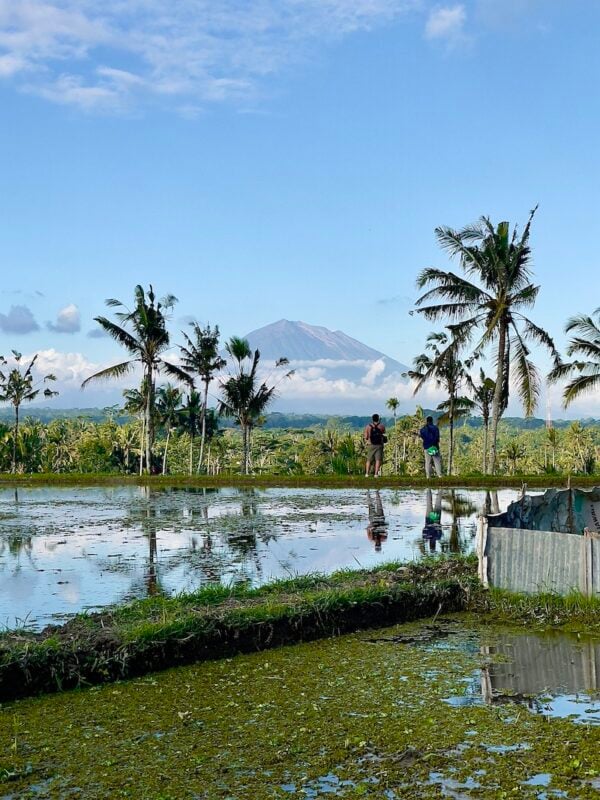
Is Hiking Mount Agung Dangerous?
While trekking Mount Agung in Bali can be done safely, it is more dangerous than many other hikes you may have done. Here’s why:
Uneven and slippery terrain. You’ll rarely be hiking over packed dirt, and instead will be slipping over loose gravel and ash. Especially on the descent, my husband and I both fell numerous times. People have also died from big falls during this hike.
Lack of local rescue services. Our guide also informed us that Bali doesn’t have helicopter rescue. Instead, if one of us got injured he’d need to run down the mountain to find some local people to help him carry us down (though I did also see emergency numbers at checkpoints along the way).
For this reason, you may consider getting Global Rescue, which offers medical advisory and evacuation services around the world.
High-altitude hiking poses risks. Along with the potential for rapidly changing weather, altitude sickness is common. My husband and I both felt dizzy and short of breath toward the top, though luckily it wasn’t too bad. That being said, your reaction may be better or worse.
Mount Agung is an active volcano. While it hasn’t erupted since 2019, it’s wise to check for status updates before embarking on this epic sunrise trek.
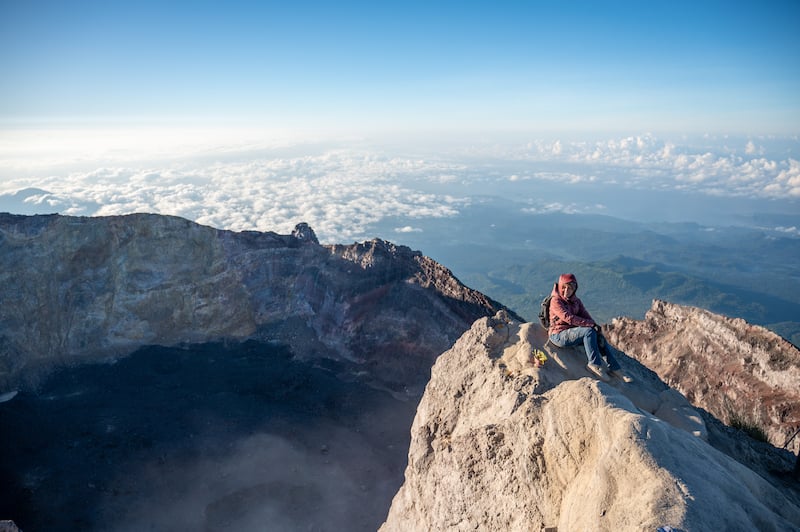
How Hard Is Trekking Mount Agung?
The Mount Agung trek is extremely difficult and relentless. You will have almost no breaks from the agony the entire time, aside from when you’re sitting and taking in the sunrise.
As I shared prior, along with being incredibly steep, the ground is not packed dirt. Instead, you’re often hiking up and down loose gravel and ash, which is incredibly slippery. The best way I can explain it is it feels like you’re hurling yourself up and down the mountain, vs actually walking.
Toward the summit, you’ll also need to climb up steep rock face covered in boulders. Personally, I found this section a lot easier than the slippery ash – mainly because I was thankful to finally feel steady; however, a few other people hiking alongside us couldn’t do this section because of knee issues. This meant they never made it to the summit even though they were so close.
To prepare for the Mount Agung Bali hike, I recommend doing some additional fitness training in the months leading up to your trip. Along with making sure you’re physically fit, running on an incline and doing the StairMaster can help you get used to the steep terrain.
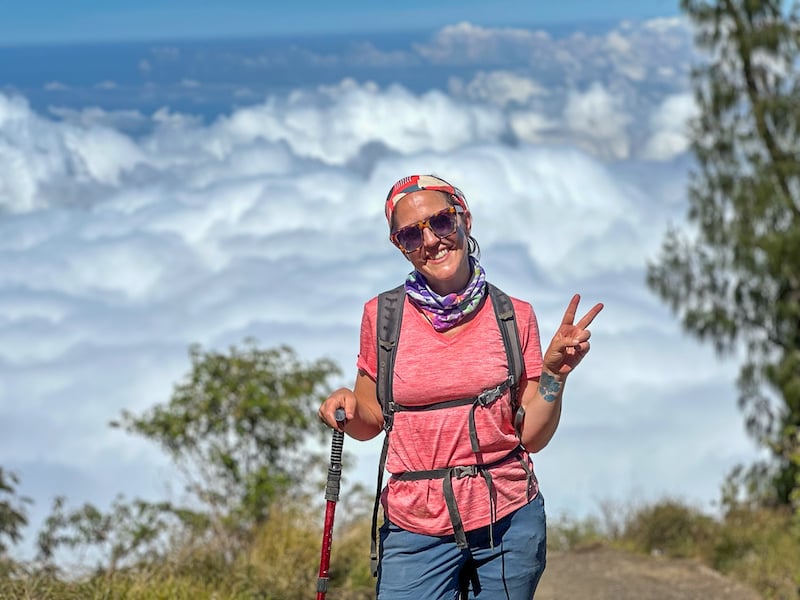
Mount Agung Trekking Routes
There are two main Mount Agung trekking routes to choose from, as well as a third rarely-used option. These include:
Besakih Temple Route
Starting Point: This route – which is the one I did – begins at the Besakih Temple, the largest and holiest temple in Bali.
Difficulty: It’s considered the most challenging route because of its length and the steepness in some sections.
Duration: Typically, the trek takes around 6-7 hours to reach the summit and another 5-6 hours to descend.
Elevation gain: There is a large elevation gain of 2,150 meters (7,000 feet).
Features: This route takes trekkers to the very highest point of the mountain; as in, the true summit. As you trek, you’ll be able to see the temple from different angles, making this route spiritually significant for many.
Trail map: Click here for a Mount Agung trail map of the Besakih Temple Route
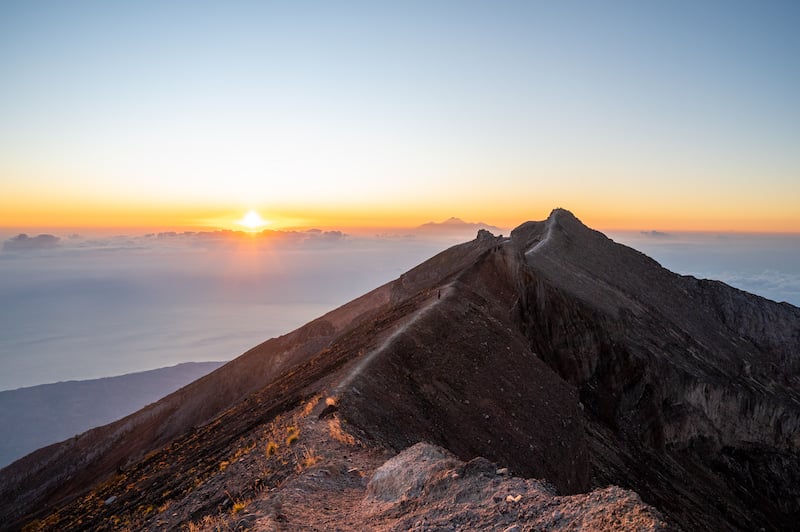
Pasar Agung Temple Route
Starting Point: The trek starts at the Pasar Agung Temple.
Difficulty: This route is shorter and somewhat less challenging than the Besakih route, but it still demands a good level of fitness.
Duration: It takes about 3-4 hours to reach the summit and another 2-3 hours to descend.
Elevation gain: This route has an elevation gain of 1,500 meters (5,000 feet).
Features: While this route doesn’t take trekkers to the absolute summit of Mount Agung, you’ll be rewarded with stunning panoramic views of almost the whole island of Bali, neighboring Lombok, and the vast ocean.
Trail map: Click here for a Mount Agung trail map of the Pasar Agung Temple Route
Duku Bujangga Sakti Route
Starting Point: This less-traveled route starts from the village of Selat.
Difficulty: It’s a challenging route, especially due to its lesser-known nature, which means the paths may not be as well-trodden.
Duration: The Mount Agung hike time for this route is typically 5-6 hours to the summit.
Features: This route offers a more solitary experience, making it ideal for those who wish to avoid the more popular routes’ “crowds” – though the Mount Agung hike is so challenging that it isn’t ever really crowded.
What Mount Agung Trekking via Besakih Temple Is Like
Our trek up Mount Agung begins at 11:30pm from the Besakih Temple. Led by our guide, Gede, we begin our ascent up the volcano in pitch black, our headlamps illuminating the path.
For the first 45 minutes — or 200 meters up — the hike is relatively easy. While not flat, it’s not too difficult, and I begin to feel hopeful that maybe the Mount Agung trek isn’t as hard as everyone makes it out to be.
I am wrong.
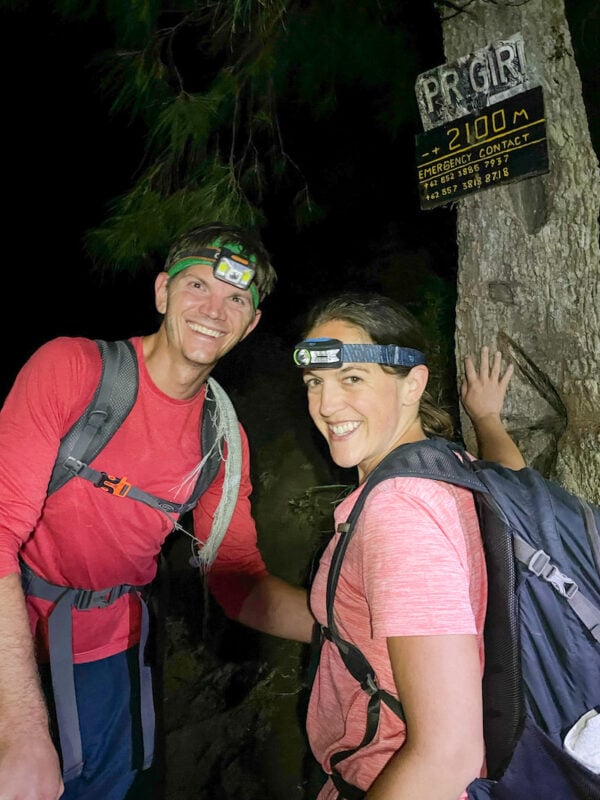
After this first checkpoint — stops along the path where you’ll see signs letting you know how far you’ve come — the trail becomes relentlessly hard.
Not only is it a steep ascent up and a true calf killer, but many sections feature loose gravel and slippery ash that make it hard not to constantly stumble.
While my trekking pole starts as a tool to help me keep my footing, it soon becomes a cane that I continuously plunge into the ground to keep from falling.
At one point, my husband asks me how I’m doing. My response: “I feel like a dead person dragging another dead person up a volcano.”
I’ve done many difficult hikes before, but this one is something else. At times, you’re truly throwing yourself up the trail, just trying not to fall. It’s also almost entirely uphill, whether you’re going up loose rock, uneven roots, or slippery ash.
Things get even more challenging at around the 4-hour mark when the effects of altitude sickness kick in: dizziness, shortness of breath, and slight nausea. At one point I start coughing, and my cough feels tight and uncomfortable.
While I probably sound negative right now, I’ll say that while I absolutely want to cry much of the time, a few things that keep me going are the stunning night sky — sometimes featuring shooting stars — and seeing Bali’s lights twinkling below. As the hike continues these lights expand, helping to make it clear just how high up you are.
I begin to get a second wind around the 5-hour mark when Gede informs us that there is only an hour left. We’re so close!
I’m also happy as this part features a steep rock scramble — and I can actually stand without falling.
Many of the articles and videos I used to research the Mount Agung hike noted this part as scary, and I’ll admit you are very high up at this point and ascending in the dark, but I actually enjoyed this section of the hike and didn’t find it too daunting.
Here is a photo of the view from here:
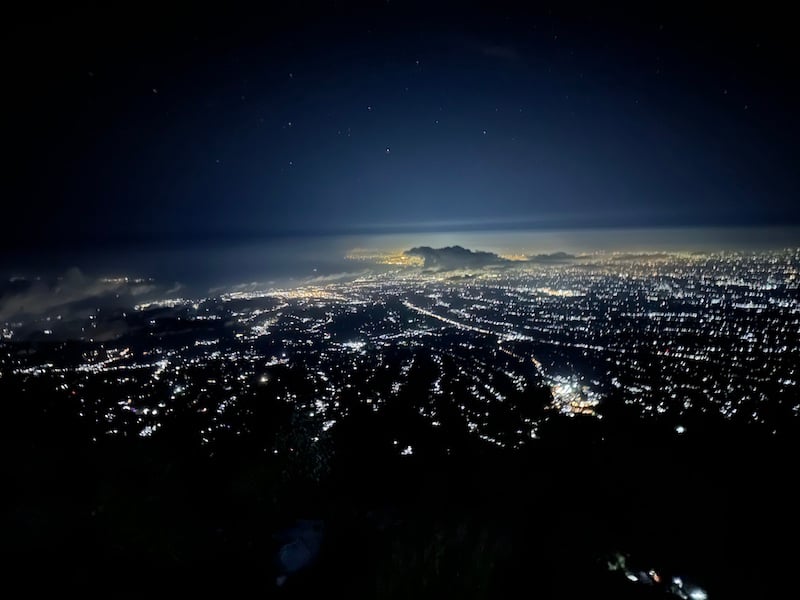
Another group of guys from Singapore hike beside us, and unfortunately one of them doesn’t continue from here due to bad knees. I definitely feel his pain, as this section requires lifting your legs high and awkwardly to get to the top.
After about 45 minutes of this, we’re on the ridge of the volcano! We walk for about 20 minutes up a semi-steep dirt path, until finally, we’ve made it:
The Mount Agung summit at 10,308 feet (3,142 meters). After 6 hours of complete agony, we finally made it.
We throw our bags down, grab our cameras, and find a rock to perch on. As the sun begins to rise over Bali, the colors illuminate the many mountains and volcanos of Indonesia’s islands.
We see Mount Batur (another popular Bali sunrise hike), the neighboring island of Lombok and its prominent Mount Rinjani volcano, and the Indian Ocean.
Not only that but as it gets brighter, it becomes clear just how high up we are — even above the clouds! It’s surreal watching the fluffy formations drift by below us.
While the Mount Agung sunrise is gorgeous, my personal favorite view is looking into the nearby Mount Batur caldera, which we’re towering over.
Here are some of my favorite photos from the Mount Agung sunrise hike:
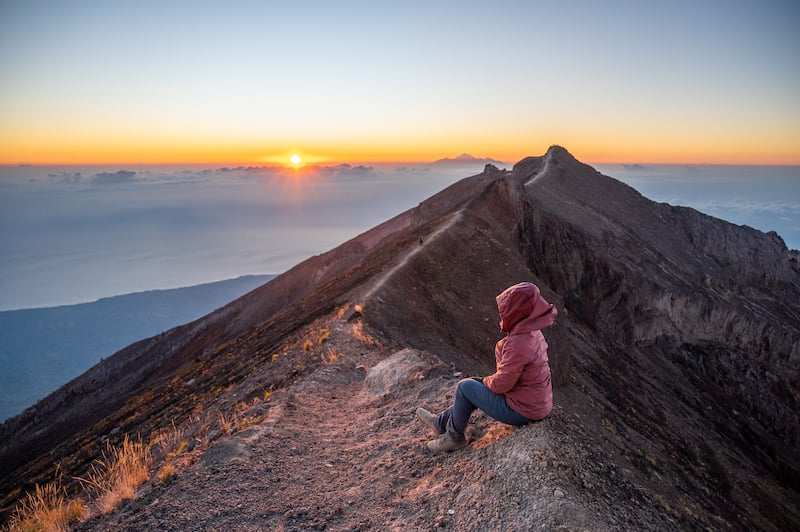

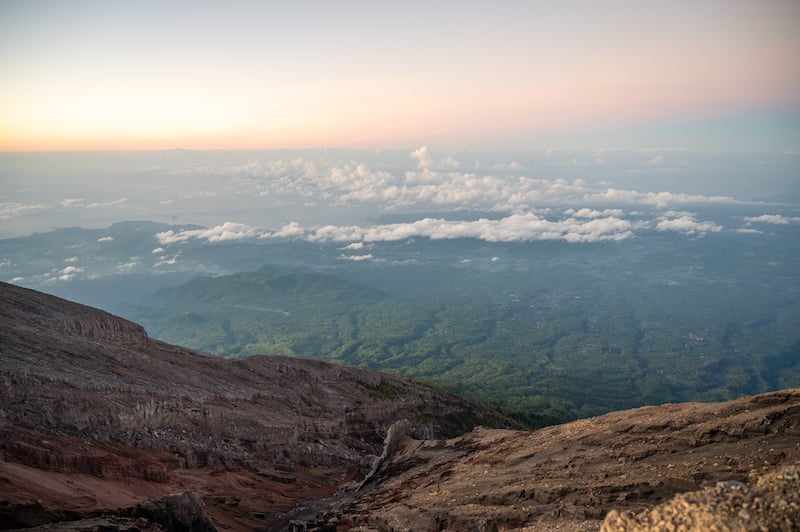
Gede makes us a tasty breakfast of hot tea and coffee, bananas, boiled eggs, and banana bread. He also has a bag of Balinese chocolate bars.
After the sun has risen, we continue walking along a very thin ridge to the edge of the Mount Agung caldera.
For me, this is the most nerve-wracking part, as if you fall you’ll truly be tumbling down an extremely steep and sheer rock wall. Basically, don’t fall during this part.
Looking into the caldera, surrounded by fluffy clouds and towering above the surrounding peaks, is an intensely moving experience.

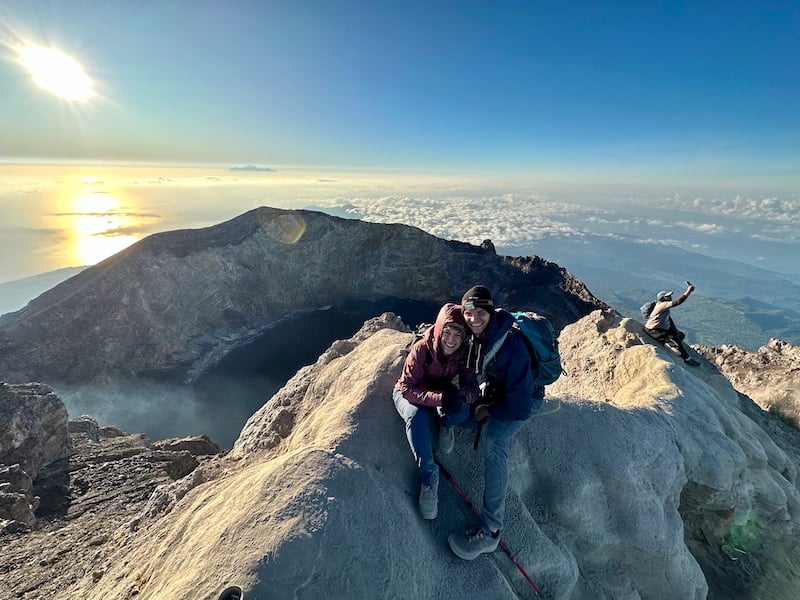
Once we’ve had our fill of Mount Agung summit beauty, it’s time to make our way back down to Besakih Temple — which proves to be harder than hiking up the volcano!
Gede estimates that it takes most guests 4-5 hours to get back down. For us, it takes 6 hours. Here’s why:
1) It is not only wildly steep but the ground underneath you is never packed dirt. Instead, you’re slipping, sliding, and falling almost the entire time.
When I ask Gede if people ever get airlifted off the mountain, he explains that isn’t an option. Instead, if you get hurt, he would need to go find some local people to help him carry you off. No, thank you.
In short, I’m not willing to break my ankle.
2) By this point, my knees and toes are killing me. As I’m 5’2”, I continuously have to lift my legs high and bend my knee over my ankle. Plus, the steep descent means my toes keep pressing against my hiking sneakers.
3) I go down on my butt almost half the time. Again, I’m not willing to break my ankle and the ground is extremely slippery.
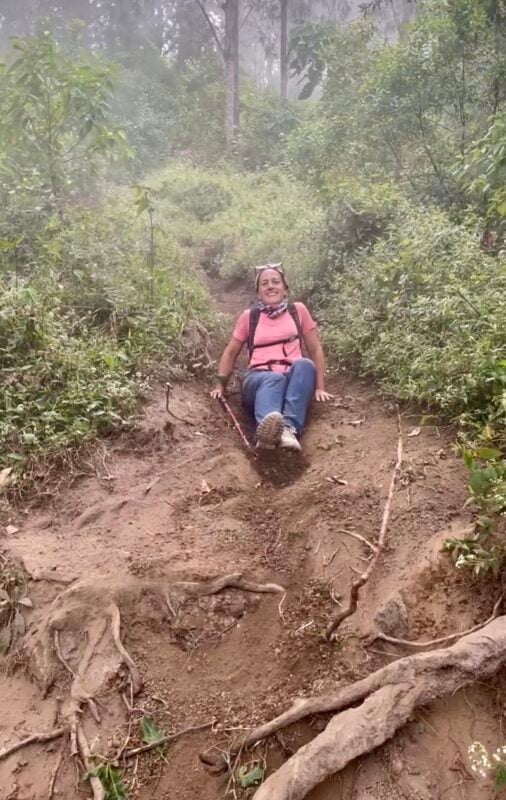
Is Hiking Mount Agung Worth It?
Personally, I think this depends on a few things:
Your sense of adventure. This is an intense and active adventure that requires you to be physically fit and willing to push through pain.
Your love of epic sunrise views. Your efforts will be rewarded with one of the best — if not the best — sunrise you’ve ever seen; but, you will need to push yourself to the limits to see it.
What type of trip you’re after. Do you want to relax and enjoy beaches, temples, and Balinese flower baths, or do you want something with more active adventures — or maybe a mix of both? This can help you decide if hiking to the top of Mount Agung is worth it.
The length of your trip to Bali. Keep in mind, you’ll lose a day when hiking the Mount Agung volcano as you’ll need a recovery day after to catch up on sleep. This may be a deciding factor for people with limited time in Bali. For instance, 7 days in Bali may not be enough if you want to tack this hike onto your itinerary, though 14 days in Bali should be.
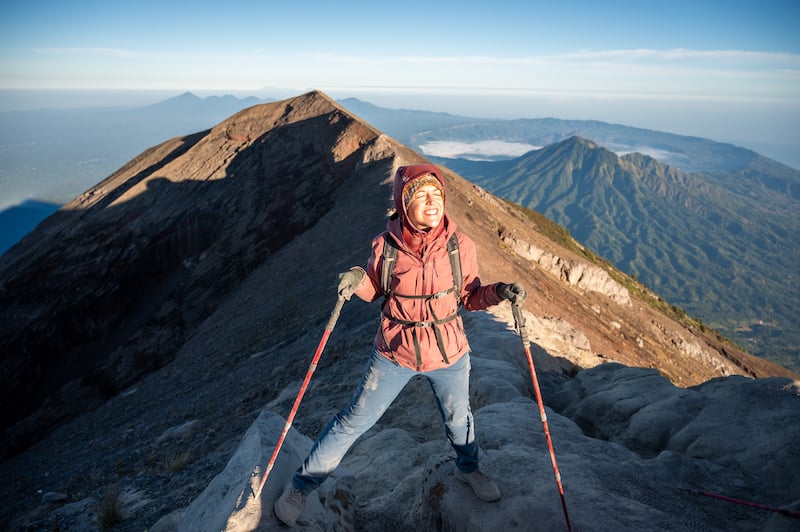
The Best Time To Hike Mount Agung
When it comes to the best time to visit Bali, you can really enjoy the destination year-round depending on what you’re looking for.
However, this is not the case when you hike Agung. This trek is very dangerous in the rain — and most operators won’t even do it if it’s raining.
I only recommend booking this if you’re visiting Bali during the dry season from April to September. August is considered the driest month in Bali.
Should You Hire A Trekking Guide?
100% yes! Whether you’re traveling solo in Bali or in a group, it’s recommended to have an experienced guide for your Mount Agung trekking experience.
There were many reasons I was happy I booked a guide through Bali Jungle Trekking:
Avoiding the Balinese mafia. There is a local trekking group, which many hikers call “the mafia,” that will try to fine you if you don’t go with a local guide. I’ve seen stories on AllTrails about hikers without a guide being extorted, harassed, and more. Having a guide will help you avoid these issues.
Having extra food and water. My Bali Jungle Trekking guide carried an extra 2 liters of water for us, which helped to lighten our loads. Additionally, he brought loads of snacks and even made breakfast at the summit including coffee, tea, hard-boiled eggs, bananas, and banana bread.
Local knowledge. With a good trekking guide, you’ll learn about what you’re seeing, which really adds to the Mount Agung hiking experience. For instance, Gede constantly pointed out what mountains we were looking at, explained the spiritual significance of Mount Agung, and more.
Safety. There are some forks in the road, and you do NOT want to turn back to see if you went the right way. Again, the Mount Agung hike is relentlessly hard. Additionally, Gede helped us safely navigate the difficult terrain without breaking an ankle.
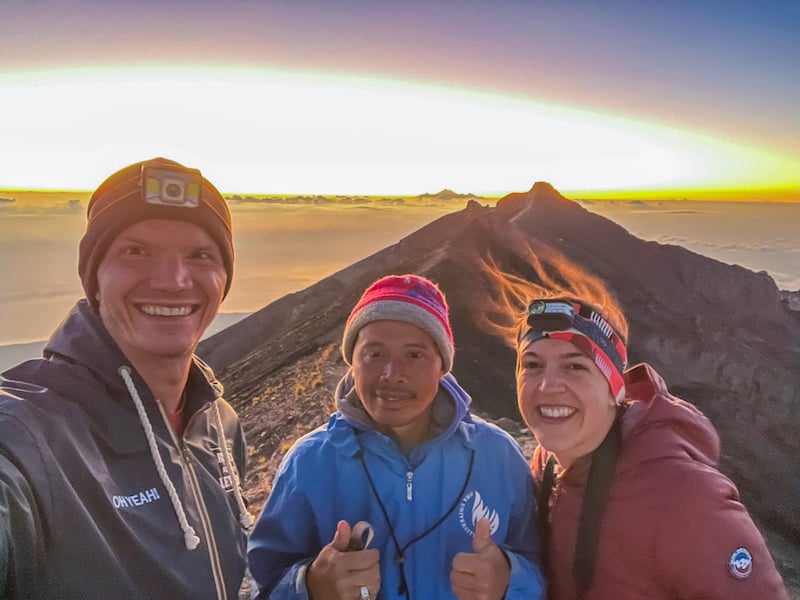
Mount Agung Hiking Tour Operator Recommendation
I recommend booking your Mount Agung trekking tour through Bali Jungle Trekking. We actually booked through another company first, but they were so unresponsive we ended up canceling and booking with Bali Jungle Trekking, and were very happy with the decision.
Along with being very responsive through WhatsApp, our pickup was prompt, our guide Gede was excellent, and we felt supported throughout the entire experience.
Mount Agung Hiking Tips
To help you prepare for your Mount Agung trekking experience, here are some essential tips:
Nap the night before. This is an overnight hike, and you’ll be trekking for 10-12 hours through the evening, with your pickup time typically being around 10pm or 11pm. I recommend taking the day of your hike easy and spending some time napping to have as much energy as possible for the trek.
Avoid a heavy evening meal. I made the mistake of having pasta at 9pm, thinking it would be digested by the time we started hiking. I was wrong, and I felt weighed down for much of the hike. Instead, consider having a heavier lunch and lighter, easily digestible dinner.
Cut your toenails. The steep descent of this hike means your toes are constantly being pressed into your sneakers – which hurts! It’ll hurt even more if you have long toenails, so make sure to clip them before hiking Mount Agung.
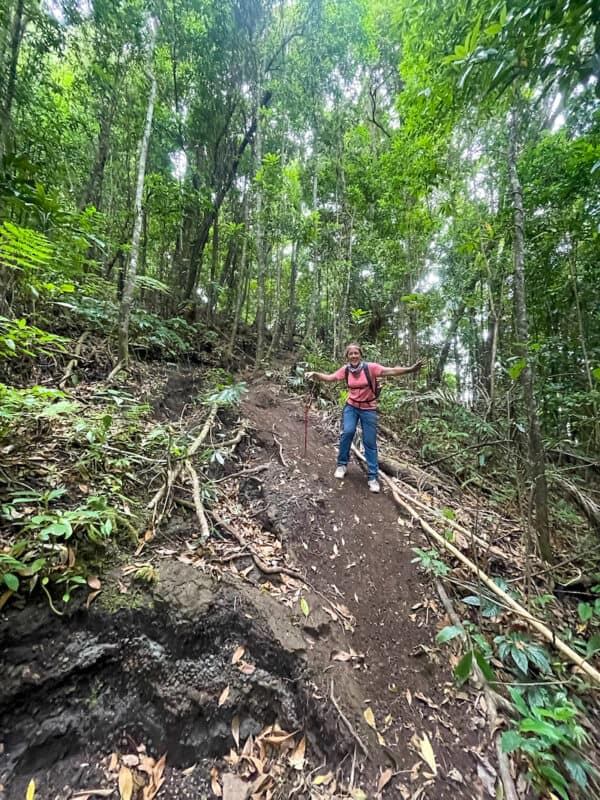
Pack a blister kit. Blisters can make hiking extremely painful, so make sure you’re prepared. As soon as you feel a hot spot, treat it immediately with something like Moleskin to avoid a blister forming.
Opt for hiking shoes/boots over running sneakers. It’s important to have shoes with good traction. You might also consider buying a pair with ankle support.
Do a sunrise timelapse. For some fun video content, record a timelapse video — and make sure to start recording when it’s still dark for a more dramatic effect.
Schedule time for rejuvenation. Specifically, book yourself a Balinese massage for the next night, as your body will be in pain. The hotel I recommend below, De Klumpu Bali Eco Tradi Stay, has an excellent spa with budget-friendly massages.
Consider how you can pack smart and light. Of course, you want to make sure you’re prepared with enough water, hiking clothing, etc; however, packing light will make it much easier to reach the summit. In the next section of this Mount Agung guide, I share some packing essentials.
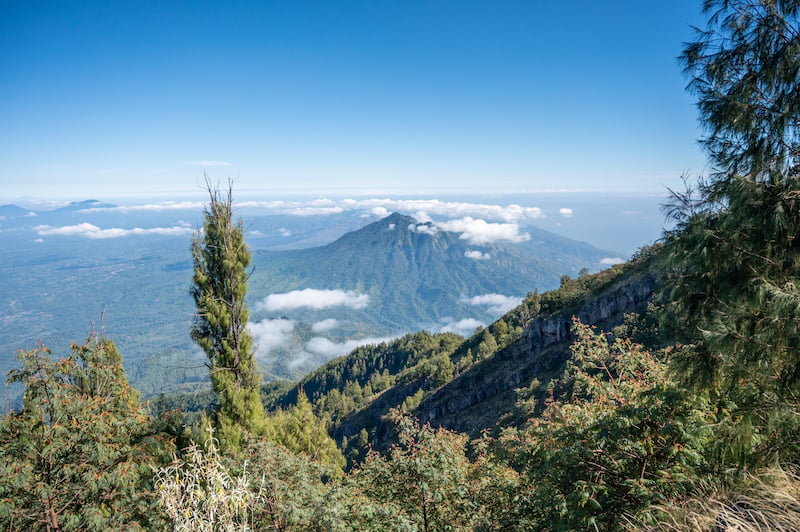
Mount Agung Packing List
When trekking Mount Agung, there are a few essentials I recommend packing. These include:
- Hiking backpack with waist belt for added stability and to help transfer pack weight to your hips
- Water – I recommend getting a water bladder (I use the Platypus 3L bladder) to make drinking on the go easier
- The hike is typically 10-12 hours round-trip, so make sure you have enough to drink. This guide from REI can help you plan accordingly, though the general recommendation is .5 liters per hour of moderate activity.
- Snacks like energy bars, fruit, and trail mix
- Hiking shoes with good traction
- Moleskin or blister treatment tape
- Hiking shorts and hiking pants – when it comes to what to wear when hiking, you’ll want pants for when it gets colder toward the summit as well as when scrambling over jagged rocks
- Down jacket – it’s cold at the summit
- Windbreaker – it’s also windy at the summit (personally I use a rainjacket for this)
- Gloves – for warmth as well as for grabbing onto rocks
- Hat – to keep your head warm at the summit
- BUFF – this can double as a scarf as well as a face covering when hiking through dusty sections
- Tissues – you’ll be breathing in a lot of dust
- Hand wipes – your hands will get very dirty as you’ll often be hiking on all fours
- Altitude sickness treatments – I really love Tiger Balm for helping with headaches
- Sunscreen and sunglasses
- Headlamp – your guide will likely supply this, but I like to bring my own high-quality one
- Trekking poles – my guide provided one low-quality pole each – mine didn’t change length – so it may be worth bringing your own
- Knee brace – your knees will be screaming
Where To Stay When Hiking Mount Agung
Most Mount Agung trekking companies will pick up from major tourist hubs in Bali like Ubud and Seminyak, though I recommend staying close to the trailhead to avoid sitting in the car for too long.
Top Pick: De Klumpu Bali Eco Tradi Stay
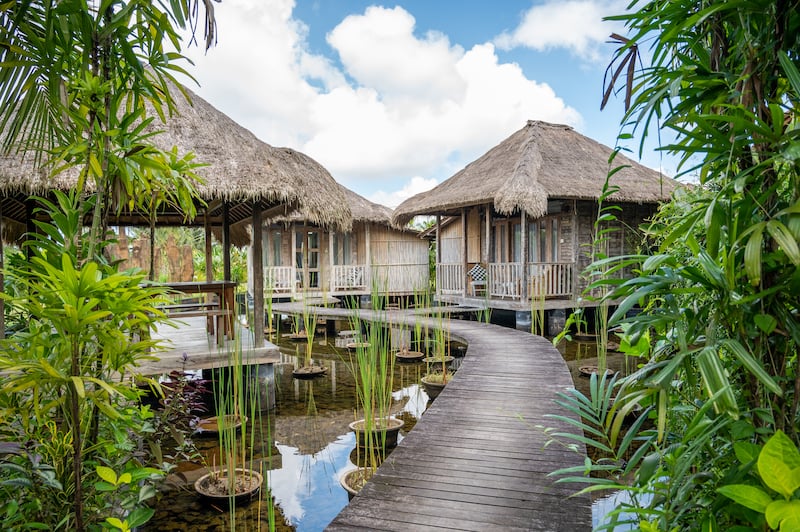
This hidden gem Bali hotel wasn’t on any listicles I saw, but I luckily found it through Booking.com. It’s a lush and remote paradise off the beaten tourist trail that allows you to truly get away and connect with nature — through the onsite tropical flora, bamboo houses, tranquil spa, and organic restaurant overlooking the rice fields.
There are many fountains and peaceful places to take in natural beauty, and if you opt for a villa you’ll also have a private patio overlooking the rice fields. The stone jacuzzi tub and outdoor shower are nice touches too!
Personal notes:
- Their restaurant serves 3 meals per day. The last meal is put in at 9pm — though on our arrival day we got in at 9:15 and were able to WhatsApp message the property to put in a food order by 9pm.
- As we were doing Bali’s Mount Agung hike and would be missing breakfast, the hotel was kind enough to make breakfast boxes for us with sandwiches, hard-boiled eggs, juice, water, and fruit.
- This property is remote so you won’t find loads of attractions like you would near Ubud and Seminyak; however, there is a lovely waterfall about a 10-minute drive away called Tukad Cepung Waterfall. It’s one of the most beautiful waterfalls in Bali.
- The hotel is a great base for hikes like the Mount Agung Trek and Mount Batur.
Another Option: Besakih Homestay & Villa
This Bali accommodation is located only a 5-minute drive or 15-minute walk to the Besakih Temple, so you’ll be perfectly located to trek Mount Agung.
Every room is equipped with a balcony, and some also have a terrace and/or mountain views. Other highlights include a shared kitchen for cooking, a garden, a picnic area, and an Asian breakfast in the morning.
Bali Accommodation Map
You can also search this map for local accommodation options. The map is currently set to Besakih, though you can easily change it to your preferred destination in Bali:
Mt Agung Trekking FAQ
Here are answers to frequently asked questions about climbing Mount Agung:
Q) What is Bali’s highest mountain?
The Mount Agung Bali volcano is the island’s highest point. It stands at 10,308 feet (3,142 meters).
Q) What is the Mount Agung hike difficulty?
Very difficult. Mount Agung sunrise trekking will test your physical and mental strength and stamina.
Q) What is the Mount Agung trekking price?
While the price varies depending on the route, company, and inclusions, you can expect to pay around $85-$110 per person.
Q) What is the weather like on Mt Agung?
Mount Agung weather is very different depending on where you are on the mountain. It is much warmer at the base of the volcano than at the top, where it is cold and windy. You’ll definitely want a jacket, hat, and scarf, and you should also come prepared for unexpected weather changes.
Q) Where can I book a Mount Agung tour?
I booked a private Mount Agung hike guide through Bali Jungle Trekking and was very pleased with their services.
Q) Can you hike Mount Agung without a guide?
Yes, but it is not recommended. Along with potentially getting harassed by the local trekking guide association – a group many people call “the mafia” – you’ll have a much easier and safer experience with a guide.
However, if you prefer to go without a guide, here are directions and a trail map.
Q) What is the best Bali volcano hike?
When it comes to Bali volcano hiking, Mount Agung offers the most amazing view. In terms of popularity, Mount Batur is a top pick.
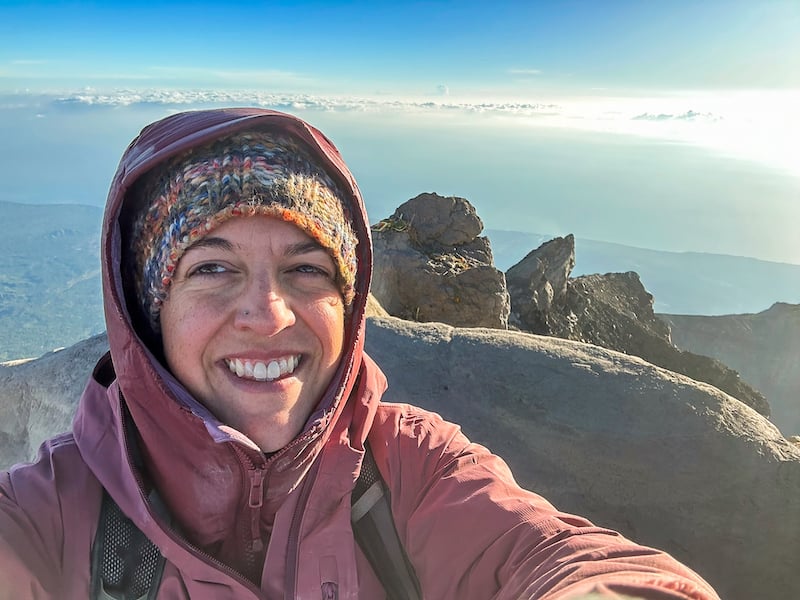
Getting Travel Insurance For Mount Agung
When visiting Bali — or anywhere else in the world — it’s wise to get travel insurance.
One of the best travel medical insurance for travelers is SafetyWing as they’ve got a large network and offer both short-term and long-term coverage — including coverage if you’re traveling for months as well as limited coverage in your home country.
Additionally, SafetyWing is budget-friendly and offers $250,000 worth of coverage with just one low overall deductible of $250.
Click here to price out travel insurance for your trip in just a few clicks.
Mount Agung Trekking: Final Thoughts
Hiking Mount Agung is an unforgettable experience offering the chance to see the sunrise from Bali’s highest point.
That being said, it’s also very challenging, so you’ll want to make sure you’re prepared.
Following the tips shared in the above Mount Agung guide can help you confidently and safely reach the summit. Make sure your phone is charged, and get ready to capture some of the best photos of your entire Bali trip!

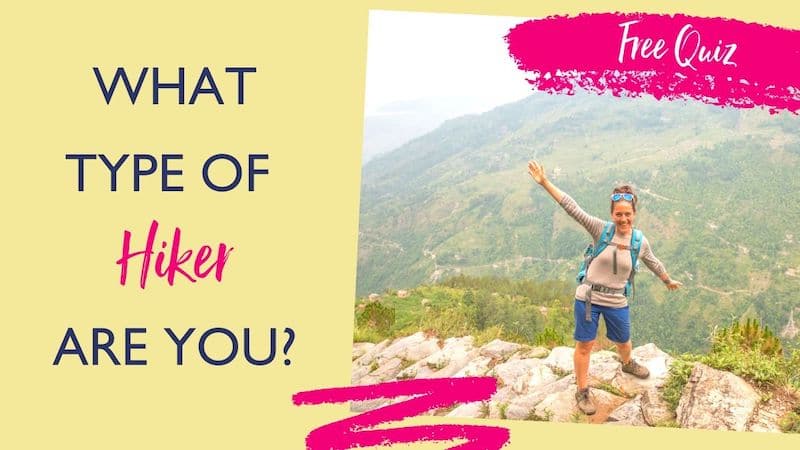
Hi, I’m Jessie on a journey!
I'm a conscious solo traveler on a mission to take you beyond the guidebook to inspire you to live your best life through travel. Come join me!
Want to live your best life through travel?
Subscribe for FREE access to my library of fun blogging worksheets and learn how to get paid to travel more!
Turn Your Travel Blog Into A Profitable Business
Subscribe to my email list to snag instant access to my library of workbooks, checklists, tutorials and other resources to help you earn more money -- and have more fun -- blogging. Oh, and it's totally FREE! :) // Privacy Policy.